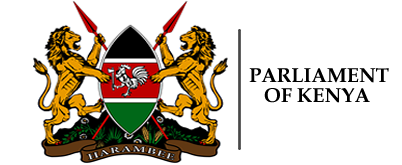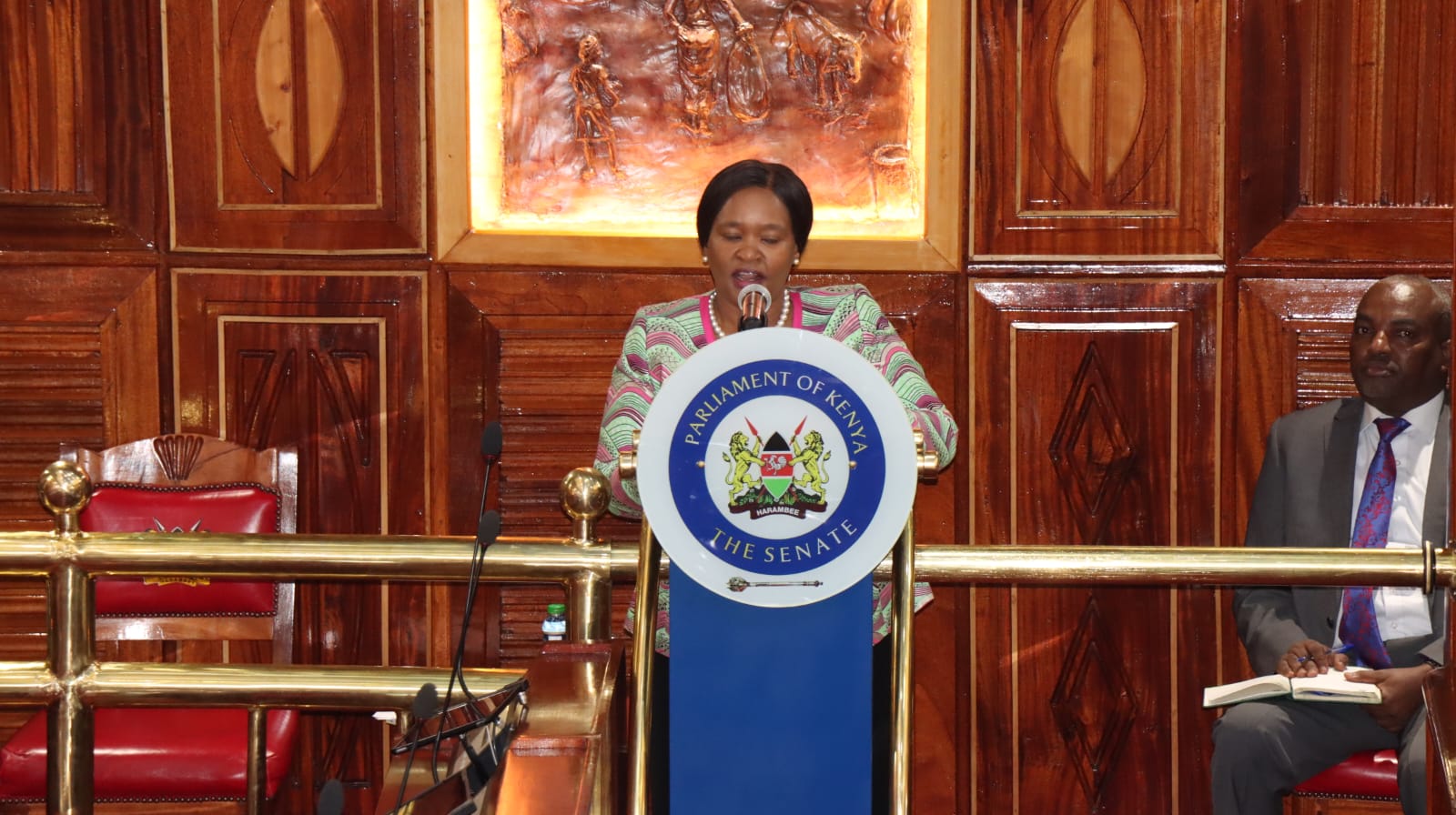𝐂𝐒 𝐑𝐄𝐁𝐄𝐂𝐂𝐀 𝐌𝐈𝐀𝐍𝐎 𝐀𝐍𝐒𝐖𝐄𝐑𝐒 𝐐𝐔𝐄𝐒𝐓𝐈𝐎𝐍 𝐈𝐍 𝐒𝐄𝐍𝐀𝐓𝐄.
The National Government will continue supporting Kenyans affected by the long drought until there will be a significant improvement. Answering questions in Senate this Wednesday, the Cabinet Secretary for East African Community (EAC), the ASALs and Regional Development Mrs. Rebecca Miano told Senators that despite rain being experienced in a section of the areas affected, the effects of the long drought are still being felt necessitating support from Government.
Below is the excerpt of the session.
𝐒𝐄𝐍. 𝐂𝐇𝐔𝐓𝐄: Could you provide a list of the relief food distribution programmes currently being run across the country, indicating the types of food being distributed and the quantity of package?
𝐂𝐒 𝐌𝐈𝐀𝐍𝐎: According to the guidelines and procedures of the management of relief food distribution in Kenya, the following committees are responsible at various levels, the state Department for Relief Food Committee, County Steering Group Relief Food Committee, Sub-County Relief Food Committee, Ward Relief Food Committee, Location Relief Food Committee, Sub-Location Relief Food Committee and Village Relief Food Committee. The following are the food items procured, rice (50kg) bag, beans (50kg) bag, maize (50kg) bag, vegetable Oil (carton (12) 1 litre) and fortified food bale (25kg).
On the humanitarian emergency response. These are non-food commodities given to households affected by various disasters. They consist of iron sheets, timber, ridges, nails (assorted), mattresses, blankets, kitchen sets, jikos, gas lamps, tents/tarpaulins, soap and sanitary towels.
𝐒𝐄𝐍. 𝐂𝐇𝐔𝐓𝐄: Who are the suppliers of relief food under these programmes from 2017 to date, and could the Cabinet Secretary state the amount paid to the respective suppliers and indicate the pending bills accrued, if any?
𝐂𝐒 𝐌𝐈𝐀𝐍𝐎: Regarding the period spanning 2017 to October 2021 until January 9, 2023 this query was redirected to the State Department for Devolution and State Department for Social Protection and Senior Citizens Affairs for competent adjudication and response. The Ministry did not inherit any pending bills as far as relief supply is concerned while payment to current suppliers is ongoing as delivery of supplies continues.
𝐒𝐄𝐍. 𝐂𝐇𝐔𝐓𝐄: Could the Cabinet Secretary explain the tendering process used to award the tenders, and provide details of the types of food products procured and the price per unit in respect of the current programmes?
𝐂𝐒 𝐌𝐈𝐀𝐍𝐎: The Ministry of Lands, Public Works, Housing and Urban Development through the State Department for Public Works (Supplies Branch Department) prequalifies contractors for supply of goods and services to various Ministries, Departments and Agencies every two years or as and when necessary. The Ministry of EAC, the ASALS and Regional Development uses the list of prequalified contractors to identify appropriate suppliers for various commodities for relief programmes. Procurement and relief food and Humanitarian Emergency Response commodities are based on the provision of Public Procurement and Assets Disposal Act, 2015. Types of food products procured from January to May were Rice-Sindano rice grade (50kg) Ksh. 7,250, Beans of various types (50kg) Ksh. 7,500 and Maize-white (50kg) Ksh. (market determined). The commodities supplied are branded “𝑮𝒐𝑲: 𝑹𝒆𝒍𝒊𝒆𝒇 𝒇𝒐𝒐𝒅 𝒏𝒐𝒕 𝒇𝒐𝒓 𝒔𝒂𝒍𝒆.”
𝐒𝐄𝐍. 𝐂𝐇𝐔𝐓𝐄: The supplied rice and edible oil was bought at how much?
𝐂𝐒 𝐌𝐈𝐀𝐍𝐎: I don’t have the actual figure but I can firmly confirm that the prices were slightly higher.
𝐒𝐄𝐍 𝐃𝐔𝐋𝐋𝐎: You have not provided an allocation to the DCCs to ensure food stuff reaches intended people and why can't you use cash transfer as a government instead of providing food that does not even reach people?
𝐂𝐒 𝐌𝐈𝐀𝐍𝐎: From February to May, I have the data to show that we are matching food distribution with the amount. On cash transfer, this is work in progress, going forward we reduce as much as possible the relief food distribution and revert to cash transfers.
𝐒𝐄𝐍. 𝐒𝐄𝐊𝐈: Can you give a list of suppliers of relief food between February and almost May?
𝐂𝐒 𝐌𝐈𝐀𝐍𝐎: The contracts are still ongoing but I have the list, I will submit.
𝐒𝐄𝐍. 𝐂𝐇𝐄𝐏𝐓𝐔𝐌𝐎: What measures have you put in place to ensure that the food supplies actually reach the targeted people?
𝐂𝐒 𝐌𝐈𝐀𝐍𝐎: We use the County Steering Groups to target the affected and vulnerable population following reports by the National Drought Management Authority. When we allocate relief food, we copy to the County Commissioner, all leaders, elected and administrative to ensure higher accountability.
𝐒𝐄𝐍. 𝐂𝐇𝐄𝐑𝐔𝐈𝐘𝐎𝐓: When are you going to update the records of your ministry regarding the classification of Arid and Semi-Arid areas?
𝐂𝐒 𝐌𝐈𝐀𝐍𝐎: We will work with KALRO and the Commission on Revenue Allocation to get a new updated classification.
𝐒𝐄𝐍. 𝐖𝐀𝐌𝐀𝐓𝐈𝐍𝐆𝐀: What is the ministry doing in order to ensure that we develop strategic reserves, post-harvest management issues so that we don’t lose a lot of food when we have good harvests?
𝐂𝐒 𝐌𝐈𝐀𝐍𝐎: We need strategic reserves, the ministry of agriculture I am aware of and have seen their documentations, strategies. We are following up with them to implement the strategies.
𝐒𝐄𝐍. 𝐋𝐎𝐌𝐄𝐍𝐄𝐍: How does the ministry ensure rural areas that have challenges in terms of road infrastructure receive food?
𝐂𝐒 𝐌𝐈𝐀𝐍𝐎: We have a transport arrangement. We get escorts from KDF and other authorities and lately we are using government vehicles.
𝐒𝐄𝐍. 𝐃𝐑. 𝐋𝐄𝐋𝐄𝐆𝐖𝐄: What measures is the Cabinet Secretary considering to ensure constant supply of emergency relief aid for communities in ASAL areas despite the rains?
𝐂𝐒 𝐌𝐈𝐀𝐍𝐎: It takes quite a long time to recover from such a drought. The effects of drought are still with us. Despite the improvement, the relief programme is still on and we will continue to support communities that require support until we get a significant recovery.
𝐒𝐄𝐍. 𝐌𝐔𝐍𝐆𝐀𝐓𝐀𝐍𝐀: Has the ministry planned for future droughts?
𝐂𝐒 𝐌𝐈𝐀𝐍𝐎: We are working on a strategy called Ending Drought emergencies in Kenya. This is the second phase. We are coming up with strategies, programmes and projects that will in future alleviate drought.
𝐒𝐄𝐍 𝐀𝐁𝐀𝐒𝐒: How is the ministry addressing disparities in the supply of food as some sub counties have more population than others yet food is distributed across board?
𝐂𝐒 𝐌𝐈𝐀𝐍𝐎: Food distribution is based on the population at the sub county level. We get data at the sub county level then it is validated by the National Drought Management Authority for our use during distribution of food.
𝐒𝐄𝐍. 𝐂𝐇𝐄𝐑𝐀𝐑𝐊𝐄𝐘: Has your ministry had a discussion with the ministry of Agriculture with the view of reviving the strategic grain reserve?
𝐂𝐒 𝐌𝐈𝐀𝐍𝐎: We are having conversations with the ministry of Agriculture but first to have sufficient food then have agriculture and farming that can have a reserve.
















